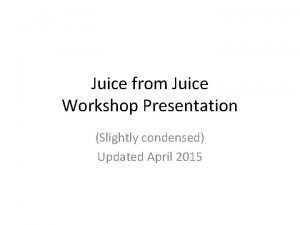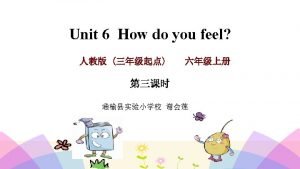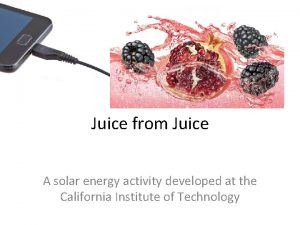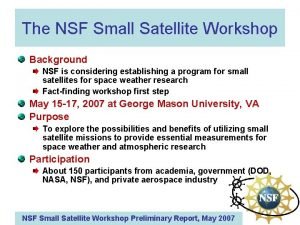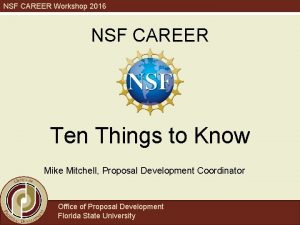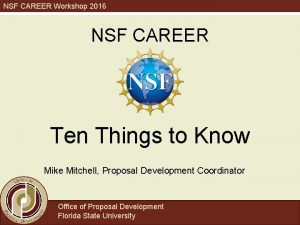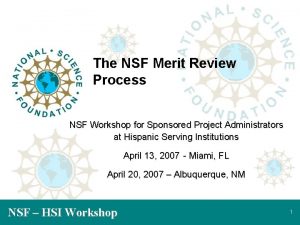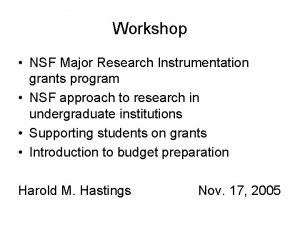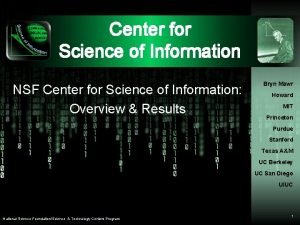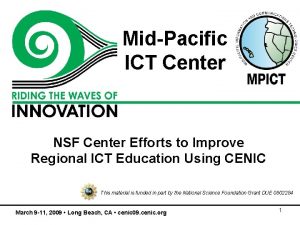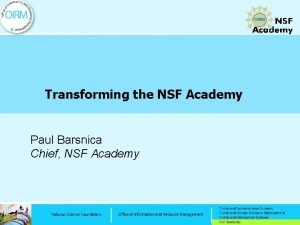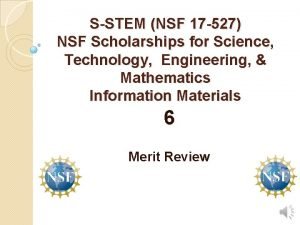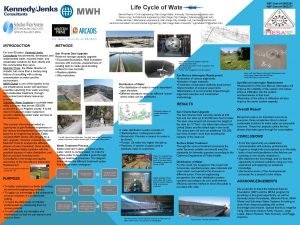Juice from Juice Teaching Workshop NSF Center for
























- Slides: 24

Juice from Juice Teaching Workshop NSF Center for Chemical Innovation: Solar Fuels

Overview of Jf. J Project • Goal: develop dye-sensitized solar cell (DSSC) kit that 1. Supports NGSS (3 rd – 12 th grade) 2. Gets students involved in solar-energy technology 3. Reinforces inquiry-based learning and invites further discussion/investigation from students • Integration of scientific concepts from multiple disciplines into one hands-on, engineering-based project Physics Light absorption Biology Chemical potential DSSC Electron transfer Chemistry Engineering

Lesson Road Map Pre-lab Related Lessons Experiment Water Splitting: Photosynthesis and Energy Storage Scientific Notation: Using a multimeter DSSC Background Information Inquiry Opportunity: Renewable energy Light as Energy: Light reflection and absorption in gummy bears Electrochemistry: Galvanic Cells, redox and the activity series DSSC Fabrication Circuits: Connecting cells in series and parallel Post-lab Calculating power and efficiency of a DSSC Next Steps Comparison to silicon solar cells and other dyes Inquiry Opportunity: Fuel Cells

What is a Solar Cell? Sony Hana Akari (“flower light”) lamps: lampshades are screenprinted DSSCs Caltech Holliston parking structure Solar window prototype by Solaronix - EPFL Traditional Photovoltaics vs. DSSCs

DSSC Components • Semiconductor Ti. O 2 • Dyes used as photosensitizers – – Chlorophyll (spinach leaves) Anthocyanin (berries, fruits) Betalin (beets) Synthetic Ru dyes Blackberry Juice • Conductive glass electrodes FTO • Redox electrolyte I-/I 3 - • Light source Projector or Sun

Juice from Juice DSSCs Dyed Ti. O 2 Sandwiched layers with electrolyte in between Ti. O 2 layer Graphite layer Completed DSSC

How do the DSSCs work? • It all has to to with energy levels and band gaps • Light provides energy to excite an electron • As the electron moves down the energy levels, it can do work and generate electricity

Energy Levels of DSSCs Image from Tan et. al. , 1994

Energy Levels of DSSCs Light excites the from dye, moving electron higher c) a) Electrons b) An collected from the. Ti. O dyeto travel isrelease transferred through the Ti. O load to reach d)electron Iodide is oxidized anto ato 2 an 2 energy the counter electrode, where are used to reduce triiodide electron back tothey the dye molecule. LUMO CB HOMO LOAD e- VB + DYE* DYE + Ti. O 2 I-/I 3 - Our load can be a light bulb or other electronic device. Today it is a multimeter.

Energy Levels of DSSCs Although we’ve spatially rearranged the energy levels, they still sit at the same energies! LUMO CB LOAD HOMO VB I-/I 3 -

Energy Levels of DSSCs The electron ‘rolls’ down the potential hill, passing through the load, and returns to the ground state in the dye. LUMO CB HOMO e. DYE VB Ti. O 2 I-/I 3 - LOAD

Energy Levels of DSSCs The sun does all the work for us! It throws the electrons to the ‘top of the hill, ’ while we simply make use of the energy of the electron as it rolls down. This is SOLAR ENERGY.

Chemical Reactions Resulting in Electron Transfer for Current Flow Reduction I 3 - + 2 e- 3 I- Oxidation 3 I- I 3 - +2 e 2 e- + - w - LEO the lion goes GER OIL RIG Image credit: http: //chemed. chem. purdue. edu/genchem/topicrevie

Why this System? • Materials are cheap, abundant, non-toxic • Right energy level alignment with all components (dyes, FTO, Ti. O 2, I-/I 3 -, etc. ) • Detectable current (I) and voltage (V) • Other options? – other fruits or synthetic dyes can be used as can other metal oxides besides Ti. O 2 – However, energy level alignment and electron transfer rates must be satisfied

Side Lesson: Using Multimeters DC = Direct Current Variable Units of Measurement Context Current ‘I’ Amps (A) = Coulomb/sec Electron travel rate Voltage ‘V’ Volts (V) = Joules/Coulomb ‘Push’ [or energy] per electron packet Resistance Ohms (Ω)= Volts/Amps Opposing force [like friction in mechanics] Power ‘P’ Watts (W) = Joules/ sec = Volts*Amps Energy transfer rate ‘R’ P = I*V Joule’s Law V = IR Ohm’s Law

Side Lesson: Building Circuits How do we maximize current or voltage from our solar cells? These symbols (resistors) represent our DSSCs! • In series • In parallel maximum voltage maximum current

Side Lesson: Building Circuits How do we maximize current or voltage from our solar cells? • In series • In parallel maximum voltage maximum current

Related Expt: Water-splitting DSSCs Water Splitting Uses sunlight to generate clean, renewable electricity Makes clean, renewable fuel from water Combine: H 2 generation using DSSCs

Related Expt: Light & Energy Nature of light • White light can be made from individual colors • Wavelengths of light can be absorbed or reflected, giving rise to the colors we see • Different wavelengths have different colors and energies

Related Expt: Electrochemistry • Electrochemistry key to the success of a DSSC • Output voltage due to reduction/oxidation (redox) reactions – Different metals have different reduction potentials – Create activity series using Zn, Cu, Sn, and Mg Galvanic cell -0. 5 0. 0 0. 5 1. 0 E (V) DSSC

DSSC Kit • Juice from Juice kits distributed by Arbor Scientific • Includes all materials for the experiment with a class of 30 – DSSC Fabrication…. . $140 • Refill of chemicals or extra glass for larger classes available in refill kit – Chemical Refill……. . . $39 – Glass Refill…. . . $15 • Most materials can be reused for several years

Other experiment Kits • Still in process of developing kits/setting prices • Also distributed by Arbor Scientific with materials for a class of 30 – Water-Splitting………. . $79 – Electrochemistry…. …. $50 • Light & Energy Experiment just requires – red & green laser pointers ($10 -20 online) – Gummy bears

“I need help!” • I don’t have enough $ for the kit! – Kids in Need Foundation, Donors. Choose. org, local power company grants – Donations from parents, PTA, bake sales – Even aluminum cans! • I don’t remember how to do it! – Lesson plans and instructional videos online http: //thesolararmy. org/jfromj – We can do a demo at your school if you are in the LA area – Email questions – juicefromjuice@caltech. edu • I don’t have time in my curriculum! – Lesson fulfills NGSS standards, cross-cutting concepts in many areas – Incorporate as much as you can – some renewable energy education is better than none!

Conclusions and goals • Integrate basic science with push towards clean energy • Get students and teachers directed toward research in solar energy conversion • Feedback and continued project development Physics Light absorption Biology Chemical potential DSSC Electron transfer Chemistry Engineering Thanks – and have fun! Questions: Juice. From. Juice@caltech. edu
 Micro teaching meaning
Micro teaching meaning Kontinuitetshantering i praktiken
Kontinuitetshantering i praktiken Typiska novell drag
Typiska novell drag Tack för att ni lyssnade bild
Tack för att ni lyssnade bild Ekologiskt fotavtryck
Ekologiskt fotavtryck Varför kallas perioden 1918-1939 för mellankrigstiden
Varför kallas perioden 1918-1939 för mellankrigstiden En lathund för arbete med kontinuitetshantering
En lathund för arbete med kontinuitetshantering Underlag för särskild löneskatt på pensionskostnader
Underlag för särskild löneskatt på pensionskostnader Vilotidsbok
Vilotidsbok A gastrica
A gastrica Densitet vatten
Densitet vatten Datorkunskap för nybörjare
Datorkunskap för nybörjare Stig kerman
Stig kerman Mall debattartikel
Mall debattartikel För och nackdelar med firo
För och nackdelar med firo Nyckelkompetenser för livslångt lärande
Nyckelkompetenser för livslångt lärande Påbyggnader för flakfordon
Påbyggnader för flakfordon Arkimedes princip formel
Arkimedes princip formel Offentlig förvaltning
Offentlig förvaltning Bo bergman jag fryser om dina händer
Bo bergman jag fryser om dina händer Presentera för publik crossboss
Presentera för publik crossboss Argument för teckenspråk som minoritetsspråk
Argument för teckenspråk som minoritetsspråk Vem räknas som jude
Vem räknas som jude Treserva lathund
Treserva lathund Mjälthilus
Mjälthilus

























